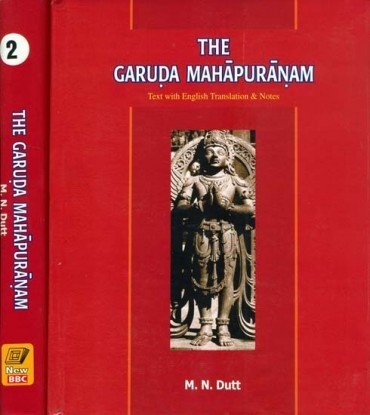The Garuda Purana
by Manmatha Nath Dutt | 1908 | 245,256 words | ISBN-13: 9788183150736
The English translation of the Garuda Purana: contents include a creation theory, description of vratas (religious observances), sacred holidays, sacred places dedicated to the sun, but also prayers from the Tantrika ritual, addressed to the sun, to Shiva, and to Vishnu. The Garuda Purana also contains treatises on astrology, palmistry, and preci...
Chapter XLII - Description of investing a phallic emblem with sacred thread
(Śiva-pavitrarohanam)
Hari said:—I will now describe the eternal rite of Shiva called Pavitrarohana[1] which, O Hara, a priest, a worshipper or his son or a person, observant of a vow, should perform. Having performed the adoration extending over full one year one should perform this rite in the month of Ashada, Shravana, Magha or Bhadrapada. He should first of all procure a thread made of gold, silver, copper or of cotton spun by a maiden. Having made nine folds of this thread he should perform the rite of Pavitrakam. With the Vamadeva mantram he should make the Granthis (knots). With the Satya mantram, O Shiva, he should wash the thread, with the Aghora mantram he should purify it, with the Tatpurusha. mantram he should tie it and with Isha mantram he should place incense. The following are known as Tantudevas or deities of the thread viz., Omkara, Chandrama, Vanhi,. Brahma, Naga, Shikhidwaja, Ravi, Vishnu and Shiva. The length of (the sacrificial thread, O Rudra, should be either one hundred and eight fingers in length, or fifty or twenty five. There are ten Granthis or knots. And the interstice between one Granthi and the other should be four fingers; or it may be two fingers or one. [The names of the ten Granthis are:—] Prakriti, Pourushi, Vira, Aparajita, Jaya,.
Vijaya, Rudra, Ajata, Manonmani and Sarvatamukhi. On the seventh or the thirteenth day of the light fortnight one should dye it with saffron and perform the Pavitrakæ rite with scents. Having sprinkled the phallic emblem with thickened milk he should rub it with scents and dedicate the sacred perfumeries to the self—the Brahman.
He should place scented flowers at the foot of the image of Ishana, sticks for cleansing teeth in the east and fruits of emblic myrobalam in the north. He should place earth in the west and ashes in the south. One, conversant with mantrams, should place, with Sikha mantram, Aguru in the south-east corner and sessamum seeds with the Kavacha-mantram, O bull-emblemed deity.
Having encircled the house with a thread he should offer sacred scents. Then after offering oblations to fire he should place offerings for pernicious spirits.
O king of gods, O Maheshvara, thou hast been invited with thy ganas (goblins). Do thou come near, I will adore thee in the morning.
Having thus invited the deity he should spend the night in singing and place, by the side of the image, sacred articles inspired with mantrams. Having sprinkled the sun with Water on the fourteenth day of the dark fortnight he should adore Rudra. He should first meditate on self, in the form of the universe, as being stationed on the fore-head and then adore it. He should sprinkle it with water with the astra mantram and adore it with the Hridaya mantram. He should next dedicate incense inspired with mantrams. He should first of all adore Shiva Tattva, then Vidya Tattva and next Atma Tattva.
Om, Haum, salutation unto Shiva Tattva (essence of Shiva). Om, Him, salutation unto the essential spirit of learning. Om, Ham, salutation unto the essence of self.
Om, Ham, Him, Hain, Kshaum salutation unto the essence of all. O God! O Shambhu! whatever, thou, identical with time, hast seen in me, whatever I have done, have offered as oblations to fire, whatever I have created, have all been done by me, by thy will, for the rite of Pavitrakam. Om, fulfill my vow of sacrifice. Om, Ham, Him, Hum, Haim, Haum, salutation unto Shiva, the lord of observances, identical with all essences and the cause of all.
With this mantram the four offerings of a Pavitraka rite should be made. Having offered Pavitrakam to the fire one should make presents unto the preceptor, offer food, feed the Brahmanas, worship Chanda and then perform the Visarjana (life-destroying) rite.
Footnotes and references:
[1]:
The rite of putting sacred thread around the neck of the image of a particular deity.
